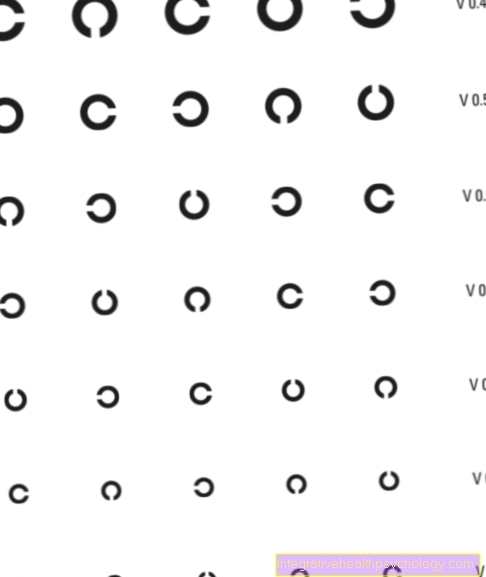
An eye test determines visual acuity (VA) of the eyes tested. This indicates the resolution of the eye, i.e. the ability of the retina (retina) to recognize two points as separate.
The visual acuity defined as normal is 1.0 (100 percent). Adolescents often achieve even better visual acuity and with increasing age, the visual acuity then decreases, which is caused by an increasing stiffness of the eye lens, but can also have other causes.
A distinction is made between near and far vision. The near vision indicates the visual acuity at a distance of about 0.3 m and is mostly needed for reading. Distant vision describes visual acuity from a distance of 1.0 m and is used when, for example, we recognize traffic signs while driving a car.
$config[ads_text1] not found
The visual acuity is checked at every examination by the ophthalmologist. In certain professions such as a pilot or police officer, a minimum visual acuity is required and must be checked and documented by an officially recognized body. Good or sufficiently corrected eyesight is also required to drive a vehicle and must also be officially checked before applying for a driver's license.
In addition to the ophthalmologist, opticians, doctors from the health department, doctors with the field of occupational medicine and doctors with the additional designation of industrial medicine are authorized to issue such a certificate of sufficient eyesight. However, they must have the necessary equipment for the examination and be sufficiently qualified to conduct it.
Visual acuity is impaired in the following diseases:
There are several ways to perform an eye test, which are explained in more detail below
$config[ads_text2] not foundThis test is a standardized DIN ring-shaped optotype that has an opening on one side, the direction of which is to be recognized by the person who is being examined for visual acuity. The line width is set so that it appears at an angle of 1 arc minute to a healthy eye with a visual acuity of 1 (100%). If the person tested is not able to correctly name the direction of the gap, there is ametropia.
Compared to traditionally used letters, the Landolt rings have the advantage that they are more difficult or difficult to guess or remember, and this test is also used to measure visual acuity in young children and illiterate people. This form of the eye test is carried out during the visual acuity check when applying for a driving license.
In 1917, this method was developed by the Japanese ophthalmologist Shinobu Ishihara using test images made up of dots of different colors to form an overall picture. The test is based on the fact that "normal sighted people" can recognize different motifs by differentiating between red and green on the test images than people who perceive these color differences less well due to a red-green weakness.
The Snellen hook eye test (named after the Dutch ophthalmologist Herman Snellen) is an optotype with the shape of a capital E with all three bars 5d in length. Both bar width and gap width each 1 d. This means that the Snellen hook is as long as it is high.
$config[ads_text3] not found
Since, unlike the Landolt ring, it does not have a round shape, only four “opening” positions are possible, namely up, left, down or right. For this reason, the rate is twice as high and the quality of the eye test is significantly worse than that of the Landolt rings.
$config[ads_text2] not foundAs with the Landolt rings, the Snellen hooks can be used to test young children and illiterate people, although this is not ideal. Even if the opening direction of the E-hook is not recognized, the test object may be able to perceive one side as blacker than the other and thus arrive at the correct result. For this reason, this eye test is not used to test the visual acuity of an expert.